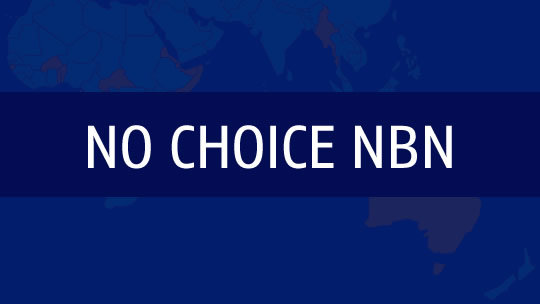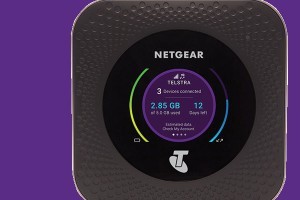
Digital Grant available
How do you market your business? Are you taking advantage of every opportunity to inform your clients and prospects of your services, USPs, achievements, promotions?
[shareaholic app=”share_buttons” id=”12025595″]

How do you market your business? Are you taking advantage of every opportunity to inform your clients and prospects of your services, USPs, achievements, promotions?
[shareaholic app=”share_buttons” id=”12025595″]

WHEN salespeople start knocking at your door to announce the arrival of the National Broadband Network in your area, there’s one important thing you should know – you can’t say no to the NBN.
Despite being one of the most talked about infrastructure projects in recent times, it seems many Australians are still in the dark about the NBN.
An online survey found 58 per cent of Australians had no idea of the repercussions of being in an NBN-ready area.
“The NBN project has been mired in controversy and has seen frequent redesigns, so it’s no wonder many Australians aren’t in tune with all its ins and outs,” Angus Kidman, technology expert and editor-in-chief at finder.com.au said.
“Many people don’t realise their existing internet service will be cut off if they don’t connect to the NBN once it has been made available at their house.
“Both your phone line and internet will be disconnected. If you’re running a business, this can be really inconvenient even if it’s just for a few days.”
Installations are expected to ramp up, with all Australians expected to be able to access the NBN within three years – by 2020.
So it’s time to get savvy, here’s what you need to know.
If you want a home phone service – not just internet – you need the NBN.
Once your home or workplace is NBN-ready, you will have 18 months at most to subscribe to an NBN plan before your phone line and internet will be disconnected.
However, in some areas (mainly apartment buildings in urban areas) third-party players such as TPG and others, will offer rival internet services so NBN does not have a total monopoly.
For those living in rural areas that are too remote to get fibre, an interim satellite will shut down on February 28, and they must switch to Sky Muster if they want to continue getting internet.
Those people knocking on your door will likely be salespeople from retailers like Optus, Telstra and iiNet offering plans for you to connect to the NBN.
This is because the NBN Co provides the service, but doesn’t actually sell broadband interest services to households.
More than 50 retail service providers are currently offering different plans at different prices so there’s plenty of choice.
Picking which one to go with is probably one of the most difficult decisions you will have to make as choosing a cheaper plan may deliver slower speeds.
Many people don’t realise their speeds are also limited by where their homes are, and how they connect to the NBN.
During recent consultation, the Australian Competition and Consumer Commission found many consumers were confused about what speeds they could get, and weren’t getting what they thought they were signing up for.
It’s a good idea to compare plans before you sign up to an NBN provider.Source:News Corp Australia
Connecting to the NBN using copper wires via the Fibre-To-The-Node technology will slow down their speeds and many are not aware how much of difference this makes.
At the moment the top speed offered by retailers is 100/40. This means you can download 100 megabits per second (Mbps) and upload 40 Mbps.
But if you are located more than 400m metres away from the “node”, which is essentially a cabinet where the copper meets the fibre optic cable, your maximum speeds will drop.
Those up to 800m metres away will probably only be able to get a maximum of 50 Mbps, and those even further away are looking at 25 Mbps.
You will not be able to get higher speeds than this, no matter which company you sign up with.
Technically, retailers are not supposed to sell you a faster contract if you are too far away from a node to get higher speeds, but this has happened.
Your home’s distance from the node is something you will have to check with the retailers as they don’t automatically tell you.
Even if you think you are close to a node (because you can see a cabinet close by), it doesn’t mean this is the node that you are connected to.
Everyone’s internet speeds will impacted by the plan that you sign up to as each company decides how much bandwidth they want to buy on the NBN network.
If the company you sign with doesn’t buy that much bandwidth (to save money), speeds can be a lot slower during peak times when there’s more demand.
Some people have complained of speeds dropping to 3 Mbps during peak times and top speeds promised may only be achieved at quiet times — like 3am.
The problem is, most companies don’t reveal what their real internet speeds are, saying only that you can get “up to” certain speeds.
If you want to get a better idea of who offers the best speeds, the Google Video Quality Report, shows the YouTube video performance over the 24-hour period for different providers, while Netflix’s ISP Speed Index can give you an idea of which retailers have the fastest speeds for their service.
The Australian Communications Consumer Action Network also has a fact sheet to help guide people through the process.
Finder.com.au has a broadband comparison tool that shows providers in your area, and how much their plans are.
An NBN spokesman said customers may get higher speeds 18 months after getting NBN because the network does not operate at full power initially to avoid interference issues with existing ADSL services.
“When an area has fully switched over to NBN Fibre-To-The-Node services we will then turn the VDSL connection up to full power — this should increase potential lines speeds by between 5-10 Mbps,” he said.
Source: Chris Chang

Lack of demand by customers to pay the hefty fees for gigabit connections shows the NBN pricing model is broken, a collection of Australian telecommunications carriers has said.
Pressure on the company responsible for rolling out the National Broadband Network (NBN) across Australia to deliver a return on investment has resulted in a broken wholesale pricing model that sees retailers pushing users onto slower plans, a collection on non-dominant Australian telcos has said.
The solution to the impasse, the Competitive Carriers’ Coalition (CCC) said, is for the federal government to write down its investment in the NBN to allow the company to reduce its wholesale charges.
“If the government recognised this and wrote off part of the wasted investment, NBN could restructure and lower its prices, and would then benefit from kick-starting sales growth in higher speed products,” a spokesperson for the CCC said in a statement.
The CCC said it was “absurd and insulting” for NBN to argue that Australians are not interested in taking up gigabit-speed connections, as NBN chief Bill Morrow repeatedly did this week.
“Currently, there are no retail 1Gbps speed plans on offer from the retailers. This is, in our opinion, because there is still minimal consumer demand for these ultra-fast speeds — especially at the prices retailers would have to charge for them,” Morrow wrote in an opinion piece.
“1Gbps speeds are simply way beyond what even the most advanced end user needs today, let alone what is needed by regular families across Australia.
“There is literally not a single mass market consumer application — or even a combination of applications — that requires 1Gbps capability right now.”
“Even if we offered it for free, we see the evidence around the world that they wouldn’t use it anyway,” Morrow said during NBN’s financial results presentation last week.
The blame for the purported lack of interest in gigabit speeds has been laid at the feet of an Australian government that is looking for a return on its AU$29.5 billion investment, which has led to an “unsustainable, self-defeating” situation where retailers make more money from slower speeds than higher ones.
“It doesn’t matter how much NBN spends on marketing; if selling higher speeds services will send retailers broke, they simply can’t and won’t do it,” the CCC spokesperson said.
“At the moment, an inflated balance sheet is driving unaffordable prices and pushing Australia in the opposite direction.”
The CCC said the switch of NBN rollout technologies from the initial Labor-backed majority fibre-to-the-premises vision to the multi-technology mix under then-Communications Minister Malcolm Turnbull had stalled the rollout, slowed take-up, and added costs.
“Australian consumers’ passion for high-speed broadband is easily seen in the mobiles market where the race for 3G to 4G and now 5G is all about meeting the download speed demands of mobile users,” the CCC said.
“Does the NBN really think customers are happy with speeds on fixed lines below those emerging for mobiles?”
MyRepublic Australia managing director Nicholas Demos also blamed the lack of 1Gbps NBN products on the network company’s connectivity virtual circuit (CVC) charge, which reserves a consumer’s bandwidth from the point of interconnect and is priced depending on usage of data.
“It’s absolute bull****,” Demos said in an interview with ZDNet.
“The CVC pricing that the NBN are charging, it’s not economical … yes, they do offer retailers such as us a product with CVC pricing — a one-gig product — but it’s just priced out of the market and no consumer will buy it at that price in Australia.”
NBN on Friday announced that it would be amending its dimension-based discounted CVC wholesale pricing model to be based on individual retailer averages rather than the previous model of using an industry average.
According to NBN, it will allow RSPs to differentiate their offerings — such as through offering higher speeds — which will then increase competition.
“We’ve taken on feedback from our customers that the discounts could be more forward-looking and so go lower … as more usage happens, so that’s what we’ve looked to do,” NBN Product and Pricing executive general manager Sarah Palmer said.
“So they’re slightly deeper discounts and there’s more of them so we get down to a AU$8 per megabit price point.”
The new model — adopted after consultation with industry, which NBN said was “broadly supportive” of the new approach — will come into effect on June 1.
In November last year, the Australia government announced it would be loaning NBN the AU$19.5 billion needed to complete its rollout under commercial terms.
“In anticipation of a future privatisation of NBN as provided for in the NBN Companies Act 2011, it is expected that this loan will be re-financed by NBN on external markets in 2020-21,” Finance Minister Mathias Cormann and Communications Minister Mitch Fifield said in November.
According to the latest Wholesale Market Indicators Report from the Australian Competition and Consumer Commission, only 90 premises across the nation are on NBN plans with speeds higher than 100Mbps.
For the top 1000/400Mbps plan, only 17 premises are connected, 500/200Mbps has 3 premises, and 250/100Mbps has 67 premises connected. All of those premises are connected via fibre-to-the-premises as NBN’s other technologies are not capable of delivering greater than 100Mbps without further upgrades.
Source: ZDNet
http://www.zdnet.com/article/telcos-call-for-nbn-write-down-to-lower-bandwidth-costs/


 A beautiful set of numbers.
A beautiful set of numbers.Stay connected on the go. Telstra has new My Business Mobile Data plans that come with more included data than ever before. You can also pool your data with all eligible devices on the same account so that you can maximise your plan.
With a My Business Mobile Data plan you can connect on the go, there’s no need to search for Wi-Fi.
Automatically share your unused data with eligible devices on the same account – the more plans you have, the bigger your data pool.
Connecting your device to the Telstra Mobile Network gives you access to the largest and most reliable mobile network in Australia.
New My Mobile Data plans are designed with sharing in mind. Share your data with your own devices or with the family.
Enjoy the freedom of sharing between phones, tablets and Wi-Fi devices all on the same account.